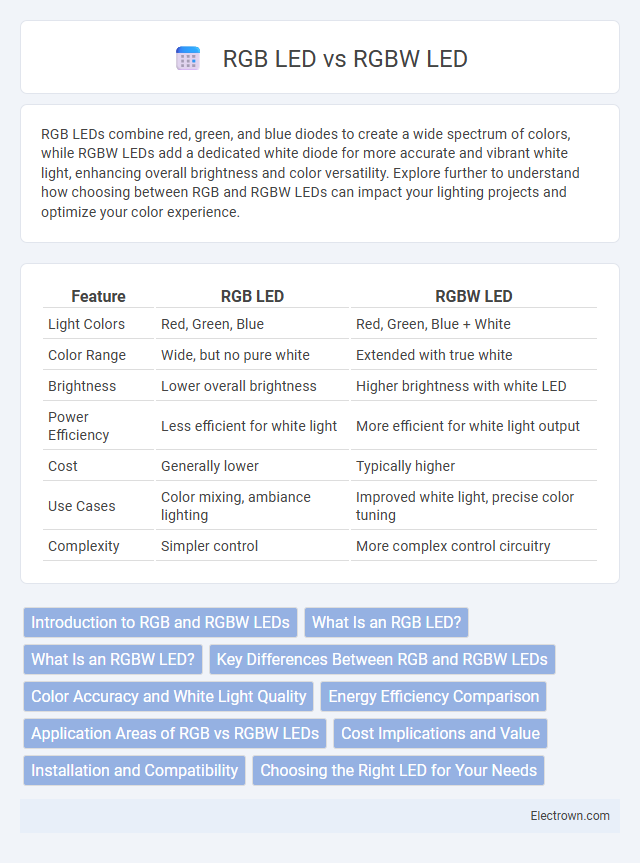RGB LEDs combine red, green, and blue diodes to create a wide spectrum of colors, while RGBW LEDs add a dedicated white diode for more accurate and vibrant white light, enhancing overall brightness and color versatility. Explore further to understand how choosing between RGB and RGBW LEDs can impact your lighting projects and optimize your color experience.
Table of Comparison
| Feature | RGB LED | RGBW LED |
|---|---|---|
| Light Colors | Red, Green, Blue | Red, Green, Blue + White |
| Color Range | Wide, but no pure white | Extended with true white |
| Brightness | Lower overall brightness | Higher brightness with white LED |
| Power Efficiency | Less efficient for white light | More efficient for white light output |
| Cost | Generally lower | Typically higher |
| Use Cases | Color mixing, ambiance lighting | Improved white light, precise color tuning |
| Complexity | Simpler control | More complex control circuitry |
Introduction to RGB and RGBW LEDs
RGB LEDs combine red, green, and blue diodes to create a wide range of colors through color mixing, ideal for customizable lighting applications. RGBW LEDs add a dedicated white diode, enhancing brightness and color accuracy while producing pure white light that RGB LEDs struggle to achieve. The inclusion of a separate white LED in RGBW improves energy efficiency and expands the color gamut for more vibrant and natural illumination.
What Is an RGB LED?
An RGB LED combines red, green, and blue diodes to produce a broad spectrum of colors through varying light intensities. This technology allows you to customize lighting effects with millions of color options by blending these primary colors. RGB LEDs are ideal for applications requiring dynamic color changes without the need for a dedicated white light source.
What Is an RGBW LED?
An RGBW LED is a type of light-emitting diode that combines red, green, blue, and white subpixels to produce a wider range of colors and enhanced brightness compared to standard RGB LEDs. The inclusion of the white LED allows for more accurate and natural white light output, improving color rendering and energy efficiency. RGBW LEDs are commonly used in displays, lighting fixtures, and smart lighting systems where precise color mixing and higher luminance are required.
Key Differences Between RGB and RGBW LEDs
RGB LEDs combine red, green, and blue diodes to create a broad spectrum of colors by mixing the three primary colors. RGBW LEDs add a dedicated white diode, enhancing brightness and producing more accurate and vibrant white light that RGB LEDs struggle to achieve. Your choice between the two depends on whether color variety or superior white illumination is more important for your lighting needs.
Color Accuracy and White Light Quality
RGB LED lights combine red, green, and blue diodes to create a broad spectrum of colors but often struggle to produce pure white light, resulting in lower color accuracy and a less natural white output. RGBW LED technology adds a dedicated white diode, significantly enhancing white light quality by delivering true white tones and improving overall color rendering accuracy. When choosing lighting solutions, your space benefits from RGBW LEDs for more precise color representation and superior white illumination.
Energy Efficiency Comparison
RGBW LEDs offer improved energy efficiency compared to standard RGB LEDs by incorporating a dedicated white LED that produces pure white light without blending red, green, and blue. This reduces power consumption for white light applications and enhances overall brightness at lower energy use. Studies indicate RGBW designs can achieve up to 30% energy savings in mixed-color lighting scenarios versus RGB setups.
Application Areas of RGB vs RGBW LEDs
RGB LEDs are widely used in decorative lighting, digital displays, and mood lighting where color variety and dynamic effects are essential. RGBW LEDs incorporate a dedicated white diode, enhancing applications in residential and commercial lighting that require accurate white light alongside vibrant colors. This makes RGBW LEDs ideal for environments demanding both colorful ambiance and functional illumination, such as retail displays and smart home systems.
Cost Implications and Value
RGB LEDs typically cost less than RGBW LEDs due to their simpler design with three color channels, while RGBW LEDs include an additional white channel that raises manufacturing expenses. The added white LED in RGBW models offers enhanced color accuracy and brightness, providing greater value for applications requiring true white light and improved color rendering. Investing in RGBW LEDs can lead to better long-term efficiency and versatility despite the higher upfront cost, making them ideal for premium lighting solutions.
Installation and Compatibility
RGB LED and RGBW LED installations differ primarily in wiring complexity and controller requirements, as RGBW LEDs typically need an additional channel for the white diode, resulting in four channels versus three in RGB setups. Compatibility issues may arise since standard RGB controllers may not support RGBW LEDs without firmware updates or specialized hardware, making it essential to verify controller specifications before installation. Proper compatibility ensures seamless integration and optimal color mixing, reducing the risk of installation errors and performance limitations.
Choosing the Right LED for Your Needs
RGB LEDs produce a wide range of colors by combining red, green, and blue light, making them ideal for dynamic lighting effects where color mixing is essential. RGBW LEDs include a dedicated white LED, delivering purer and more vivid white light alongside the color spectrum, enhancing brightness and color accuracy for applications requiring a natural white tone. Selecting between RGB and RGBW LEDs depends on whether your project prioritizes vibrant color mixing or high-quality white illumination for balanced color rendering.
RGB LED vs RGBW LED Infographic

 electrown.com
electrown.com